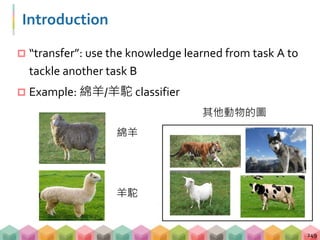This document is a presentation from a deep learning practical course, outlining core topics like machine learning, deep learning, and their applications. It describes the frameworks for training deep learning models, including multi-layer perceptrons and convolutional neural networks, along with essential techniques such as gradient descent and stochastic gradient descent. The session also includes a hands-on tutorial using Pokémon data to illustrate these concepts in practice.







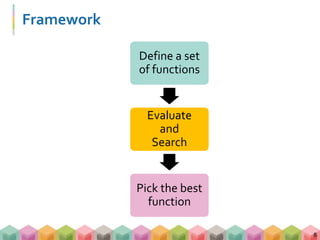






































![處理名目資料
Nominal variables (名目資料)
{"SugarFree","Half","Regular"}
One-hot encoding
假設有三個類別
Category 1 [1,0,0]
Category 2 [0,1,0]
給予類別上的解釋 Ordinal variables
{"SugarFree","Half","Regular"} 1,2,3
特殊的名目資料:地址
台北市南港區研究院路二段128號
轉成經緯度 {25.04,121.61}
61](https://image.slidesharecdn.com/dl20180414seanv3-180427172852/85/Baisc-Deep-Learning-HandsOn-47-320.jpg)



![Read Input File
65
import numpy as np
# 讀進檔案,以 , (逗號)分隔的 csv 檔,不包含第一行的欄位定義
my_data = np.genfromtext('pkgo_city66_class5_v1.csv',
delimiter=',',
skip_header=1)
# Input 是有 200 個欄位(index 從 0 – 199)
X_train = my_data[:,0:200]
# Output 是第 201 個欄位(index 為 200)
y_train = my_data[:,200]
# 確保資料型態正確
X_train = X_train.astype('float32')
y_train = y_train.astype('int')](https://image.slidesharecdn.com/dl20180414seanv3-180427172852/85/Baisc-Deep-Learning-HandsOn-51-320.jpg)
![Input
66
# 觀察一筆 X_train
print(X_train[1,:32])](https://image.slidesharecdn.com/dl20180414seanv3-180427172852/85/Baisc-Deep-Learning-HandsOn-52-320.jpg)

![Output
68
# 轉換成 one-hot encoding 後的 Y_train
print(Y_train[1,:])
# [重要] 將 Output 從特定類別轉換成 one-hot encoding 的形式
from keras.utils import np_utils
Y_train = np_utils.to_categorical(y_train,5)
# 觀察一筆 y_train
print(y_train[0])](https://image.slidesharecdn.com/dl20180414seanv3-180427172852/85/Baisc-Deep-Learning-HandsOn-54-320.jpg)


![步驟 1+2: 模型架構
71
from keras.models import Sequential
from keras.layers.core import Dense, Activation
from keras.optimizers import SGD
# 宣告這是一個 Sequential 次序性的深度學習模型
model = Sequential()
# 加入第一層 hidden layer (128 neurons)
# [重要] 因為第一層 hidden layer 需連接 input vector
故需要在此指定 input_dim
model.add(Dense(128, input_dim=200))
Model 建構時,是以次序性的疊加 (add) 上去](https://image.slidesharecdn.com/dl20180414seanv3-180427172852/85/Baisc-Deep-Learning-HandsOn-57-320.jpg)


![Softmax
Classification 常用 softmax 當 output 的 activation function
Normalization: network output 轉換到[0,1] 之間且
softmax output 相加為 1 像 “機率”
保留對其他 classes 的 prediction error
75
Output
0.6
2.6
2.2
0.1
e0.6
e2.6
e2.2
e0.1 e0.6+e2.6+e2.2+e0.1
Normalized by the sum
0.07
0.53
0.36
0.04
Exponential
Softmax](https://image.slidesharecdn.com/dl20180414seanv3-180427172852/85/Baisc-Deep-Learning-HandsOn-60-320.jpg)


![Loss Function
binary_crossentropy (logloss)
categorical_crossentropy
需要將 class 的表示方法改成 one-hot encoding
Category 1 [0,1,0,0,0]
用簡單的函數 keras.np_utils.to_category(input)
常用於 classification
78
−
1
𝑁
𝑛=1
𝑁
[𝑦 𝑛 log 𝑦 𝑛 + (1 − 𝑦 𝑛)log(1 − 𝑦 𝑛)]
0
1
AnswerPrediction
0.9
0.1
−
1
2
0 log 0.9 + 1 − 0 log 1 − 0.9 + 1 log 0.1 + 0 log 1 − 0.1
= −
1
2
log 0.1 + log 0.1 = − log 0.1 = 2.302585](https://image.slidesharecdn.com/dl20180414seanv3-180427172852/85/Baisc-Deep-Learning-HandsOn-63-320.jpg)









![88
# Sequential (依序的)深度學習模型
model = Sequential()
model.add(Dense(128, input_dim=200))
model.add(Activation('sigmoid'))
model.add(Dense(256))
model.add(Activation('sigmoid'))
model.add(Dense(5))
model.add(Activation('softmax'))
model.summary()
# Functional API
from keras.layers import Input, Dense
from keras.models import Model
input = Input(shape=(200,))
x = Dense(128,activation='sigmoid')(input)
x = Dense(256,activation='sigmoid')(x)
output = Dense(5,activation='softmax')(x)
# 定義 Model (function-like)
model = Model(inputs=[input], outputs=[output])](https://image.slidesharecdn.com/dl20180414seanv3-180427172852/85/Baisc-Deep-Learning-HandsOn-73-320.jpg)

![Advantages for Functional API (2)
Easy to manipulate various input sources
90
x2
Dense(100) Dense(200)y1x1 outputnew_x2
x1 = input(shape=(10,))
y1 = Dense(100)(x1)
x2 = input(shape=(20,))
new_x2 = keras.layers.concatenate([y1,x2])
output = Dense(200)(new_x2)
Model = Model(inputs=[x1,x2],outputs=[output])](https://image.slidesharecdn.com/dl20180414seanv3-180427172852/85/Baisc-Deep-Learning-HandsOn-75-320.jpg)








![為什麼 Cross-entropy 比較好?
99
Cross-entropy
Squared error
The error surface of logarithmic functions is steeper than
that of quadratic functions. [ref]
Figure source](https://image.slidesharecdn.com/dl20180414seanv3-180427172852/85/Baisc-Deep-Learning-HandsOn-84-320.jpg)







![Sigmoid, Tanh, Softsign
Sigmoid
f(x)=
Tanh
f(x)=
Softsign
f(x)=
107
Saturation 到下一層的數值在 [-1,1] 之間
(1+e-x)
1
(1+e-2x)
(1-e-2x)
(1+|x|)
x](https://image.slidesharecdn.com/dl20180414seanv3-180427172852/85/Baisc-Deep-Learning-HandsOn-92-320.jpg)












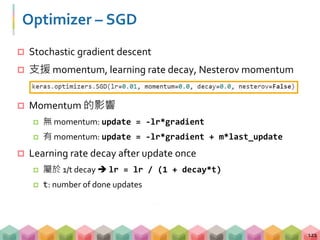













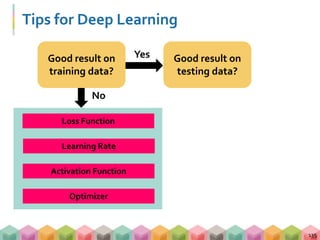















![加入 Early Stopping
151
# 指定 batch_size, nb_epoch, validation 後,開始訓練模型!!!
history = model.fit( X_train,
Y_train,
batch_size=16,
verbose=0,
epochs=30,
shuffle=True,
validation_split=0.1,
callbacks=[earlyStopping])
''' EarlyStopping '''
from keras.callbacks import EarlyStopping
earlyStopping=EarlyStopping( monitor = 'val_loss',
patience = 3)](https://image.slidesharecdn.com/dl20180414seanv3-180427172852/85/Baisc-Deep-Learning-HandsOn-135-320.jpg)





















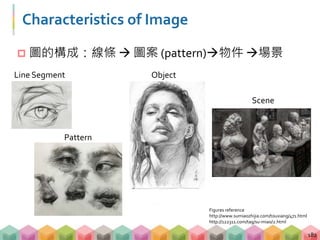









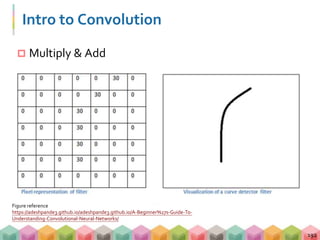










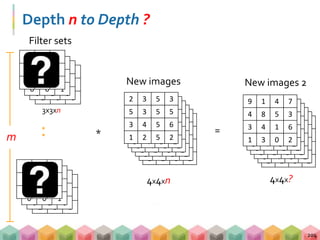








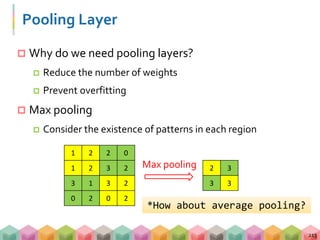




![A CNN Example (Object Recognition)
CS231n, Stanford [Ref]
218](https://image.slidesharecdn.com/dl20180414seanv3-180427172852/85/Baisc-Deep-Learning-HandsOn-192-320.jpg)




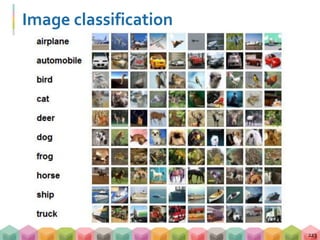


![How to Load CIFAR-10 Dataset by Keras
This reading function is provided from the Keras
226
# this function is provided from the official site
from keras.datasets import cifar10
# read train/test data
(x_train, y_train), (x_test, y_test) = cifar10.load_data()
# check the data shape
print("x_train shape:", x_train.shape)
print(“y_train shape:", y_train.shape)
print("numbers of training smaples:", x_train.shape[0])
print("numbers of testing smaples:", x_test.shape[0])](https://image.slidesharecdn.com/dl20180414seanv3-180427172852/85/Baisc-Deep-Learning-HandsOn-200-320.jpg)
![Show the images
227
import matplotlib.pyplot as plt
%matplotlib inline
# show the first image of training data
plt.imshow(x_train[0])
# show the first image of testing data
plt.imshow(x_test[0])](https://image.slidesharecdn.com/dl20180414seanv3-180427172852/85/Baisc-Deep-Learning-HandsOn-201-320.jpg)

!['''CNN model'''
model = Sequential()
model.add(
Convolution2D(32, (3, 3), padding='same',
input_shape=x_train[0].shape)
)
model.add(Activation('relu'))
model.add(Convolution2D(32, (3, 3)))
model.add(Activation('relu'))
model.add(MaxPooling2D(pool_size=(2, 2)))
model.add(Dropout(0.25))
model.add(Flatten())
model.add(Dense(512))
model.add(Activation('relu'))
model.add(Dropout(0.5))
model.add(Dense(10))
model.add(Activation('softmax'))
Building Your Own CNN Model
229
32 個 3x3 filters
‘same’: perform padding
default value is zero
‘valid’ : without padding
CNN
DNN](https://image.slidesharecdn.com/dl20180414seanv3-180427172852/85/Baisc-Deep-Learning-HandsOn-203-320.jpg)
![Model Compilation
230
'''setting optimizer'''
# define the learning rate
learning_rate = 0.00017
# define the optimizer
optimizer = Adam(lr=learning_rate)
# Let’s compile
model.compile(loss='categorical_crossentropy', optimizer=
optimizer, metrics=['accuracy'])](https://image.slidesharecdn.com/dl20180414seanv3-180427172852/85/Baisc-Deep-Learning-HandsOn-204-320.jpg)
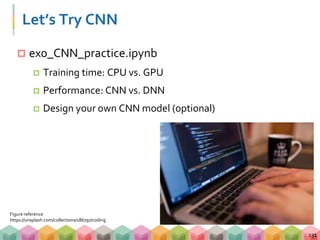












![Fill mode
ImageDataGenerator(fill_mode='wrap',
zoom_range=[4, 4])
Fill mode: reflect, wrap, nearest, constant (cval=0)
244http://www.sohu.com/a/208360312_717210](https://image.slidesharecdn.com/dl20180414seanv3-180427172852/85/Baisc-Deep-Learning-HandsOn-218-320.jpg)




